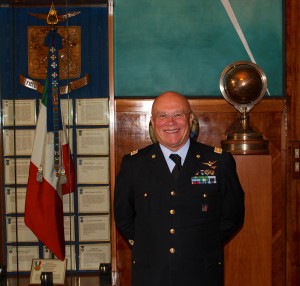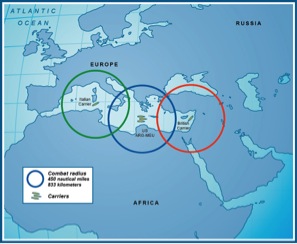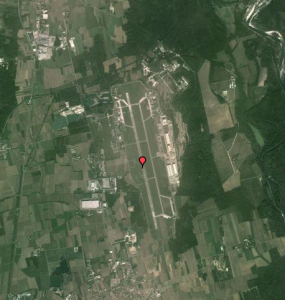2013-12-09 By Robbin Laird
Recently, Lt. General (Retired) Deptula chaired a key fighter conference in London.
He underscored that a new innovative approach to thinking about the future of airpower was needed.
According to Deptula “the future needs an agile operational framework for the integrated employment of allied military power.”
And he added: “multi-nationality may be the only way to meet our fighter force requirements.”
Clearly, some key U.S. allies feel the same way.
One of these is clearly the Chief of the Italian Air Force.
Lt General Preziosa laid out his perspective during my October 2013 visit to Italy.
He started by underscoring the nature of global change. He saw the period through World War II to end of the first decade of the 21st century as having more in common than different. He saw this as a period, which saw significant disruption and then growth built around building up continental focused growth and development. Global regions grew and financial systems largely supported those regions in their growth and development.
Airpower has been largely linear during this period, in which new planes have been added, but they have essentially replicated what we asked planes in World War II to do. Bombers and fighters have over time gotten better, but essentially they work in a linear strike and defense pattern in shaping an approach towards longer-range operations.

With the information age, he sees a different type of development, globalization in which the focus is upon inter-continental growth and development. In this phase, we have to meet the challenge of new growth and development models, shape new financial systems and deal with new defense and security challenges.
“Partnerships are changing; continents are working to get closer and to work more effectively with one another. But there is a governability shortfall in managing the new challenges, and in such areas of shortfall the problems appear. There are continuing conflicts within and among continents but there are also new patches of emerging challenges within the seams of the global system whereby terrorists, organized crime or forces of instability grow and disrupt.”
With the range and distance of erupting threats, and the need for global cooperation or coalitions to deal with them, airpower needs to be modified.
“We now need to have assets which operate in a distributed manner with coalitions engaged to deal rapidly with problems. The advantage of airpower is its reach, speed and mobility. The challenge is to coalesce capabilities to put resources rapidly up against threats and challenges early enough to deal with them.”
More by chance, than by design, the F-35 is entering the global scene at this moment in global history.
“This is an information warfare airplane which can share data across a fleet of global players. The reach of the F-35 means that my planes operating in the Western Mediterranean can receive data from throughout the region. And it is a plane with coalition designed into the aircraft.”

The plane is an information warfare aircraft, or an aircraft built to operate very differently from legacy aircraft.
“We will start with the plane and operate in a more traditional manner. But the new pilots will learn how different it is and will shape new approaches. When I started with an F-104 and then we transitioned to the Tornado, we applied the F-104 tactics to the new Tornado. We did not focus on the presence of the second man in the cockpit, the navigator, and needed to shape new approaches to use the new capabilities built into the Tornado. It will be similar as we transition from legacy aircraft to the F-35.”
The difference is that the change will even be more disruptive and more radical.
“Command and control capabilities are built into every cockpit of the F-35; the challenge will be to leverage those capabilities and the distributed decision making capabilities inherent in a fleet of F-35s.”
He underscored that a strategic shift towards pockets of defense and security challenges around the European, African, Mediterranean and Middle East regions meant that Europe, the United States and others needed to shape collaborative approaches to insert airpower when appropriate rapidly.
And the F-35 as a key distributed force asset was the right match for meeting distributed challenges.
“The fusion system built into every cockpit will allow shared coalition decision making that is required for the kinds of multi-national operations which are becoming the norm. We are not fighting in mass; we are applying tools rapidly and directly to discrete problems and challenges.”
He saw the approach at Cameri where it is part of a global production and sustainment system as symmetrical with the new strategic realities as well.
“Australia, Japan, Italy, the UK, the U.S. and others will share their production and sustainment capabilities for the F-35 and learn how to apply lessons learned from the use of a coalition aircraft in dealing with the evolving 21st century problems. This is not yesterday’s aircraft being applied to the challenges of the next 30 years; it is about reshaping concepts of operations for coalitions meeting the evolving new challenges and operational requirements.”
He emphasized that the presence of Australia in Afghanistan demonstrated that a country far from a geographical area moved force into deal with a threat identified by a coalition with which it worked. And airpower has been central to Afghan operations.
“We use airpower for virtually everything to support the guys on the ground. They rely heavily upon airpower to deliver the ordinance to protect them and to engage the enemy.”
He argued that: “We will discover the new dimension of airpower using this type of aircraft.”
The coalition quality of the aircraft is built in was a key theme of his discussion.
“Interoperability is built into the aircraft; we use the same combat systems; we fuse data the same way; we have the same symbiology in the cockpit. It will be up to the new generation of pilots and squadron leaders to figure how to maximize these inherent advantages.”
He emphasized the importance of cultural change.
“We older pilots adapted to the information revolution. The new pilots are native to that revolution. They will learn differently and this plane is designed for them.”
We closed by looking at some final issues.
The first issue is the question of why the Italian Air Force was mixing its fleet between As and Bs.
“We studied the issue carefully and for the kind of missions we face we needed the flexibility which the B can add to the fleet. We need to go to the mission not the airfield. We will operate in many areas where there are only short runways; the B allows us to operate in those conditions.
We can mix the fleet and operate at sea on land, on our own ships or own others. It is the kind of flexibility, which we see as crucial to a 21st century setting.
I will give you an example of what we don’t want. We planned to operate with the USMC in Afghanistan. But we were three months later in the deployment than we intended because our Tornados could not operate in the same conditions as the USMC. We had to take three months to build out the air base from which we would operate with them.
Time is crucial to many of the missions in which we will be engaged. The Bs give me a more rapid insertion aircraft.”
The second issue is the impact of the F-35 on the legacy fleet. Although the F-35 provides for a new approach, clearly the Italian Air Force and every other F-35 partner will look to use their legacy aircraft for a considerable period ahead, and seek to use them more effectively as the F-35 fleet becomes a reality.

“This is an important issue. One way to think about the way ahead is to continue to use 4th generation aircraft in surging mass to more classic airpower situations. One would use the F-35 as the key asset up against the distributed operational settings or for operations in denied air space.
Another way to look at it will be to find ways to gain more synergy between the F-35 and the legacy fleet. How can we better utilize our older assets during the process where the F-35 fleet becomes a reality?
Shaping combinations of 4th generation with the F-35s will be a mix and match opportunity in tailoring airpower to the missions ahead.
This is a challenge; but it is a key task within which the F-35s will make the legacy aircraft more effective; and the 4th generation aircraft will add support and strike capabilities to an F-35 enabled air power force.”
He then added that when he was speaking of airpower, he was not simply speaking to the question of an air force. All of the services are enabled by airpower.
“The Navy is not defined by its ships but by its operational reach and this comes with airpower. The Army tends to think of airpower in terms of their helicopters, but Afghanistan teaches a different lesson. Continents are working together; why not the services?”
He concluded by emphasizing that the line between those countries that operate in the fifth generation and those that don’t will be more than just a line in the sand.
“It will first of all be about survival. Do you want to be the Eagle or the Chicken in an airpower confrontation?
And there is the key question of the cultural revolution associated with the aircraft. With an aircraft with coalition capabilities built in, one will need to learn to operate differently, and this difference is central to the new phase of airpower. One needs to get on with it.”
In this slideshow, several photos taken from the Italian Air Force’s official website are highlighted to give a perspective on the force.
[slidepress gallery=’italian-air-force-slideshow’]
- The first 3 photos show various units of the Italian Air Force in combat.
- The fourth photo shows an Italian predator.
- The fifth photo shows an Italian Tornado.
- The sixth, seventh and eighth photos are of Italian F-16s.
- The ninth photo is of an Italian C-130.
- The final photos are of Italian Eurofighters.
http://www.aeronautica.difesa.it/Pagine/default.aspx
And for an overview of the Italian Air Force see:
http://en.wikipedia.org/wiki/Italian_Air_Force
And for the celebration of the Italian Air Force’s 90th birthday in March 2013 see:
http://www.difesa.it/EN/Primo_Piano/Pagine/Italian_Air_Force_90.aspx
Lt General Preziosa on Partner Cooperation and Threat Management
In this 2010, the then head of the Italian Air Force Training Command made a presentation before COMDEF 2010 in Washington DC on the future of transatlantic cooperation. Some of the themes in this brief anticipated part of his October 2013 interview.
For additional stories on the Italians and the F-35 see the following:
https://sldinfo.com/lessons-learned-at-cameri-their-implications-for-asia/
https://sldinfo.com/cameri-and-the-f-35-building-out-a-new-manufacturing-facility/
https://sldinfo.com/an-update-from-cameri-on-the-cameri-f-35-campus-october-2013/
https://sldinfo.com/building-out-an-f-35-fleet-sustainment-center-in-italy/
https://sldinfo.com/another-aspect-of-f-35-culture-change-building-out-the-cameri-facility/
https://sldinfo.com/visiting-the-italian-air-ministry/
Two of these stories appeared in earlier versions as well on Breaking Defense as well.
http://breakingdefense.com/2013/11/italian-air-force-chief-speaks-on-f-35-lt-gen-preziosa/
http://breakingdefense.com/2013/11/lessons-learned-at-cameri-italys-f-35-hq-implications-for-asia/
For a Special Report on the Italians and the F-35 see the following:
https://sldinfo.com/cameri-italy-and-the-f-35-special-report/
https://sldinfo.com/flipbooks/Italy/ItalianF-35SpecialReport1/

